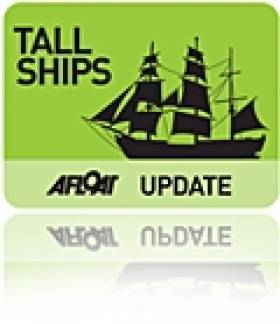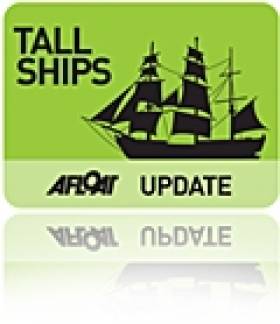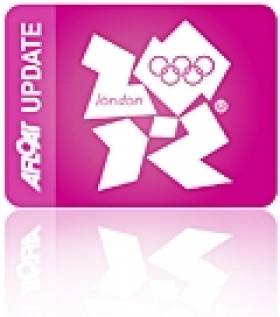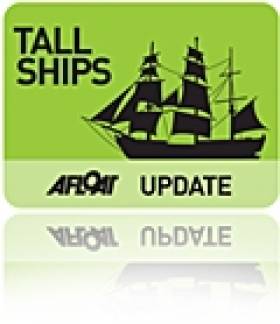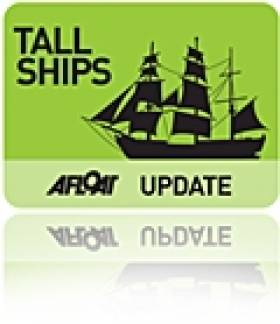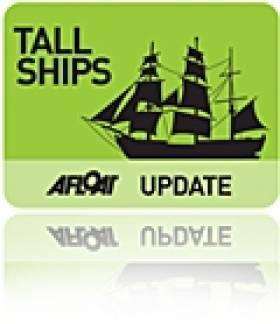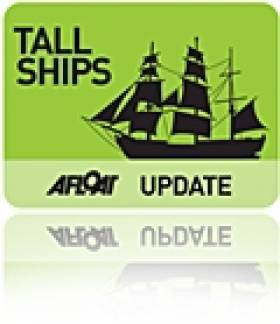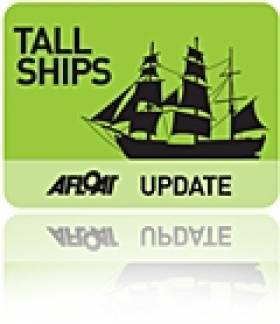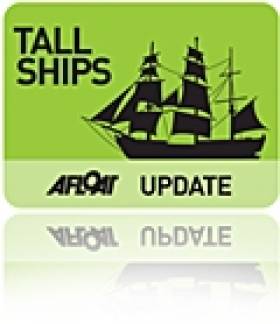Displaying items by tag: Tall ship
'Stolen' Items Recovered From Astrid Wreck
#Astrid - Items thought to have been stolen from the wreck of the tall ship Astrid near Kinsale have been surprisingly recovered from the vessel this week.
As previously reported on Afloat.ie, the ship's bell and compass were listed among items believed by owner Pieter De Kam to have been stolen in a night-time raid on the stricken sail training vessel around Friday 26 July.
That was just days after the brig struck rocks near the Sovereign Islands, prompting the rescue of all 30 crew on board.
But according to TheJournal.ie, no report of theft was ever made to gardaí - and a group of divers solved the mystery once and for all two days ago when they recovered the ship's bell, compass and wooden wheel.
TheJournal.ie has more on the story HERE.
#tallships – Another great day for The Tall Ships Races 2012 and Dubliner sailor Holly Byrne Scoops prestigious Award ahead of 7,000 international sail trainees
More than 200,000 people arrived in Dublin city yesterday as it came alive with a spectacular festival to herald the arrival of 40 splendid Tall Ships to the capital as the Tall Ships Races 2012 commenced.
Day two saw the Tall Ship's Crew Parade take place along the North side of the Quays with thousands of people gathering to see 1,800 crew members from 15 countries around the world parading up the quays to the Custom House where an international sailing award ceremony took place. A total of 28 awards were presented with the most anticipated awards being; The Torbay Cup, The Sail Training International Friendship Cup and the winning ship of the overall Tall Ships Race 2012. (for full list see grid in notes)
Dubliner Holly Byrne won the prestigious Sail Training International Torbay Cup, beating off stiff competition from 7,000 traineesover 30 countries around the world.
The Torbay Cup
The Torbay Cup was established by Torbay, UK (the first port to host a Tall Ships Race) and is presented to a trainee for outstanding individualachievement and personal effort. Holly was nominated by her captain on the Stavros S. Niarchos, Liam Kelly (Irish) for her extraordinary effort. Holly was a trainee on the Asguard II 4 years ago and has overcome the experience of the ship sinking to board the Stavros and share her story with the crew. Every Captain from each ship on the various legs of The Tall Ships Races 2012 was invited to nominate a trainee who has taken part in The Tall Ships Races 2012, Holly was chosen as the overall winner by theinternational judging panel.
The Sail Training International Friendship Trophy
St IV won the principal award at the end of each race series, the Sail Training International Friendship Trophy. This trophy epitomises the objective of the races and is awarded to the vessel which, in the opinion of the entire racefleet through a secret ballot, has done most to help further international understanding and friendship during the races.
The Fryderyk Chopin won the overall Tall Ships Races based on corrected times.
The TallShips Races 2012-Dublin which will run until Sunday afternoon will see The Minutes, Ryan Sheridan, Ash and Mark Geary take to the stage at the Bulmers Live Music Dock today while Hanover Quay will be awash with skateboarding, BMX stunts, street art and parkour as the adrenaline-fulled Kings of Concrete kicked off. Grand Canal Square will offer an epic adventure for all the family with an instant sea orchestra, comedy acrobatics, a wooden family games area, underwater themed interactive installations and music. The Waterways Ireland Visitor centre played host to puppet shows, model boat building workshops and a duck race. Grand Canal Dock hosted and incredible water experience. Well-known Dublin author Peter Sheridan will host a reading at Festival Hub at CHQ and Turtle Bunbury hosted a reading on the MV Cadhla Barge. When dusk settled on the city the floating cinema commenced and an animated historical tour of the city took place.
Class prizes for the race from La Coruna to Dublin donated by the host ports of Saint-Malo, Lisbon, Cadiz, La Coruna and Dublin.
RNLI To Play Big Part in Olympic Torch Relay
#OLYMPICS 2012 - The RNLI will play a "key role" during the Olympic torch relay ahead of the London games this summer, as Yachting and Boating World reports.
On 28 May the Olympic torch is set to visit Anglesey in north Wales, when it is taken along the Menai Strait on board the RNLI's Annette Mary Liddington.
The torch will again be carried by RNLI volunteers on 18 July when it is ferried to shore from a tall ship in Dover harbour aboard the all-weather lifeboat City of London II.
Dover RNLI's operations manager Roy Couzens said: “We are very much looking forward to being involved on the day – and believe me, when that torch is at sea in our lifeboat, it couldn’t be in safer hands!”
The Olympic torch relay begins in Plymouth on 19 May and finishes at the Olympic Stadium on 27 July. Its two-month-long journey will take it throughout Britain and Northern Ireland, and includes a visit to Dublin on Wednesday 6 June.
An interactive map of the complete torch relay route is available on the official London 2012 website HERE.
Celtic Mist Finally in Dry Dock for Refitting
#TALL SHIPS - RTÉ News reports that the Celtic Mist is finally in dry dock for refurbishment to begin its new life as a maritime research vessel.
As previously reported on Afloat.ie, the 52-foot yacht - which was gifted by the Haughey family to the Irish Whale and Dolphin Group (IWDG) to assist in its marine wildlife conservation work - relocated to its new berth at Kilrush, Co Clare in July.
This followed its last jaunt at sea earlier this year, completing a leg of the Tall Ships Races from Waterford to Greenock.
The cost of refurbishing the yacht for research and training purposes is expected to top €60,000, with an annual running cost of some €20,000, for which the IWDG is seeking ongoing financial assistance.
The group aims to get the Celtic Mist back at sea before next summer.
Alexander von Humboldt II' Christened in Bremerhaven, First Voyage in October
"We all are happy to send off "Alexander von Humboldt II" soon for its first major voyage", Willi Schäfer beams with joy. He is project manager for the ship's construction and chairman of the board of Deutsche Stiftung Sail Training (DSST). The charity DSST, owner and operator of "Alex II", will use the ship starting at the end of October to familiarize young people and people young at heart with traditional seamanship. Everybody can participate. The first winter voyage will see the three-masted ship sailing from Bremerhaven to several ports on the European continent, to Madeira and to the sailing area of the Canary Islands. The new year will see "Alex II" calling the Cape Verde Islands before it will sail to Ireland visiting Portugal on the way. The barque is expected back in its homeport of Bremerhaven in April 2012.
Diedrich Rickens, chief executive officer of DSST, rejoices about the new ship as well: "The old "Alexander von Humboldt" often did not have enough room to offer a bunk to all those interested in sailing her. The new ship can host a crew of 79, that means 20 people more than before." Rickens adds that "Alex II" fulfils international safety and security standards and is operated according to IMO regulations. That simplifies visits to countries like the USA.
Although a modern ship, "Alex II" offers traditional seafaring experience, says Reimer Peters of the project team: "This three-masted ship is new, but its construction is very traditional." As a proof in point Peters mentions the lowerable yardarms featured as well on the most legendary square riggers like "Passat" or "Gorch Fock". Lowerable yardarms make it possible to set the square sails by lifting up the round poles fixed horizontally to the mast.
Safety aspects are certainly not seen in a traditional way: the most modern equipment like electronic sea maps, satellite telephone and high speed work boats (RIB) are available to the crew in double format. Below deck it is much more comfortable than on an old traditional sailing ship: the crew is sleeping in air-conditioned 4-bunk-compartments with showers attached.
Manfred Hövener, who initiated the reconstruction of a lightship into the proud green square rigger „Alexander von Humboldt" in 1986, is happy about the successor as well: "Naturally I am a bit melancholic about the retirement of our old "Alex", but the new ship gives us so many more possibilities. And the most important thing is," adds DSST pioneer Hövener;" that the charitable cause of the foundation can be continued." He wishes that many more generations learn traditional seamanship on "Alexander von Humboldt II", form friendships and simply enjoy life. Just like it has been for the past 25 years on the old "Alex".
Ownership of „Alexander von Humboldt II", which was built at a price of 15 Mio Euro, will be transferred from the building shipyard BVT Brenn- und Verformtechnik Bremen GmbH to DSST at the beginning of October.
Before setting out for its first big winter voyage, training trips for the voluntary staff crew are on the schedule. Meanwhile, the old "Alex" will be retired by the foundation. Several potential buyers came forward, but for the time being the famous barque with the green sails will remain pier side in Bremerhaven. "We are not time-pressured to sell the old ship. The finance concept for the new build is secured without the sales profit", explains Wolfgang Arlt, chief financial officer of DSST.
By the way: "I would like to thank all those who supported the building of "Alexander von Humboldt II", stresses Willi Schäfer. "Only due to the donations in money and material by donors and sponsors we were able to realize the new build", he points out.
Technical Data Alexander von Humboldt II
Length 65 meters
width 10 meters
height main mast 33 meters over water surface
draught 5 meters
sail area 1,360 square meters, divided into 24 sails
engine power 550 kW
crew 79 sailors (among those 25 staff crew)
home port Bremerhaven
owner and operator Deutsche Stiftung Sail Training
Celtic Mist to Berth in Kilrush Creek Marina, Co Clare
Shannon Development is sponsoring the IWDG by providing a berth for Celtic Mist at Kilrush Creek Marina as the Company sees it as an important asset for West Clare. Shannon Development's Regional Development Manager for Clare Finbarr Brougham said: "We are delighted that IWDG secured Celtic Mist for Kilrush Creek Marina as it will provide a significant focal point of interest in the Marina and should attract a number of visitors to the yacht with the consequent knock on effect to the town of Kilrush. We would like to take the opportunity of wishing the Irish Whale and Dolphin Group every success in relation to the future use of Celtic Mist."
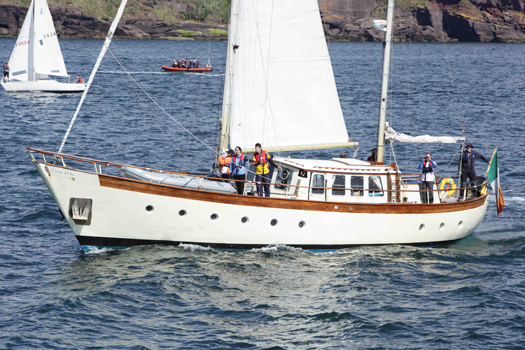
Celtic Mist is heading for Kilrush. Photo: Shay Fennelly
The yacht will be used for research and surveying for whales, dolphins and other marine wildlife in Ireland. It will also be used for training people to carry out marine surveys including the use of acoustic monitoring with towed hydrophones.
IWDG Co-ordinator Dr Simon Berrow said: "The marine wildlife around Ireland is superb, with whales, dolphins, seals, seabirds and basking sharks abundant at different locations and times of year. However we still know relatively little about what occurs where and why. Celtic Mist will provide a fantastic platform from which to survey Irish waters and help us learn more about this fantastic resource."
All are welcome to visit Celtic Mist when she arrives in Kilrush on Saturday 16 July. The expected time of arrival is between 1500h and 1600h but it is advisable to check www.iwdg.ie for confirmation.
As the cost of running a yacht like the Celtic Mist will be a major drain on scarce resources, the IWDG are looking for sponsors to help them fund its operation. Anyone interested can get further information by contacting IWDG at www.iwdg.ie
The Tall Ships are Here! (Arrival Photos)
After a long wait for the Tall Ships, they're finally sailing in Irish waters again. Photographer Gary O'Mahony captured some of the arrivals into Waterford yesterday.
Hosting of the Tall Ships Race will be worth an estimated €25 to €35 million to the regional economy, with 500,000 visitors expected to attend the four-day festival. More on Tall Ships in Ireland HERE.
Irene of Bridgewater, Pelican of London in the background

John Laing

(Above and below) Sorlandet of Norway


Christian Radich of Norway as it passes Arthurstown
Tall Ship Eagle To Arrive in Waterford Tomorrow
The crew of the Coast Guard Barque Eagle, America's Tall Ship, is scheduled to arrive at the Frank Cassin quay in Waterford tomorrow, a month ahead of the Tall Ships festival in the city.
To track Eagle's current position now off the Irish coast click here.
Ireland is the first port call during the Eagle's 2011 summer training cruise, which celebrates the ship's 75th anniversary of its construction in Hamburg, Germany, in 1936. To follow Eagle's journey on Facebook, visit www.facebook.com/coastguardcuttereagle.
Dubin's Lord Mayor opened a Tall Ship and Youth Sail Training Workshop with an agenda to seek a solution to the current Irish Sail Training impasse caused by the loss of sailing's Asgard II and Lord Rank.
Over 70 delegtes including many of the 'top brass' of the Irish Tall Ship commuunity attended the meeting held at the offices of Dublin Port Company on Saturday (26th March). The meeting inlcuded members of Coiste an Asgard, port companies, education, tourism and other sailing interests.
The meeting was formally opened by Dublin Lord Mayor and Port Admiral, Gerry Breen who introduced the chairman Lord Glentoran and the Facilitator Michael Counahan.

From (Left to right) Seamus McLoughlin, Dublin Port Head of Operations, Enda Connellan, Chairman Tall Ships Dublin 2012, Des Whelan, Chair Tall Ships Waterford 2011, Lord Glentoran (Robin Dixon) Chair Tall Ships Belfast 1992, Dr. Gerard O'Hare, Chair Tall Ships Belfast 2009, Ted Crosbie, Tall Ships Cork and Enda O'Coineen, LetsdoitGlobal.
Des Whelan gave an excellent talk and presentation on Tall Ships Waterford which was followed by a discussion on the massive economic benefits of bringing Tall Ships Festivals To Dublin, Cork and Belfast. Chairman of Tall Ships Dublin 2012 Enda Connellan and Ted Crosbie of Tall Ships Cork and Dr. Gerard O' Hare of Tall Ships Belfast discussed the incredible success stories from their respective ports festivals.
Several presentations and discussions followed regarding the role of Tall Ships in Sail Training, the connection between a vessel for Ireland and running events here. The question of who are the stakeholders and how can benefits be quantified was also discussed.
The meeting was hosted by Dublin Port Company who provided a warm welcome, excellent facilities, refreshments and a wonderful lunch with senior management attending to everyone's needs.
After lunch there were further discussions on what is the most suitable vessel, who should run the organisation and what would work best for Ireland.
Jimmy Tyrrell gave a short, eloquent and emotional account of Asgard II and the realisation of his father's dream which was fulfilled beyond all expectation by that legendary vessel and those who were privileged to sail on her. He affirmed his own belief that the way forward was with an All-Ireland Tall Ship and even suggested that she be called Spirit of Ireland. There were other suggestions for a name inlcuding 'Ireland's Call'.
A view was also expressed that politics and religion have no place in Sail Trail Training and the future lay in an All-Ireland Commercial/Charitable Trust Venture.
The prohibitive nature of current legislation and the total lack of awareness of the maritime sector by the Government was mentioned several times.
Ocean Youth Club NI provided four young sail trainees to address the gathering on the benefits of Sail Training from their perspective and representatives from education, tourism Tall Ships International and "Association Of Tall Ships Organisations" also contributed.
The general consensus was the need to develop and promote, as a matter of urgency, a plan for a Tall Ship For Ireland linking Youth, Maritime Education, Business and Tourism.
Another workshop will be held in Belfast in April and the collective input of both meetings will be considered going forward.
A Tall Order for Ireland? HERE
Regular updates on Irish Tall Ship sailing news HERE
More on Asgard II HERE
A Tall Ship for Ireland? - Poll
Should Ireland be represented at the Tall Ships Races at Waterford 2011 and Dublin 2012? We want your vote on our Facebook Poll HERE.
Looking for further reading on Tall Ships in Ireland? Click the links below:
Click this link to read all our Tall Ships Stories on one handy page
Previewing Ireland's Tall Ships 2011 Season
Can Ireland Get a New Tall Ship?



























